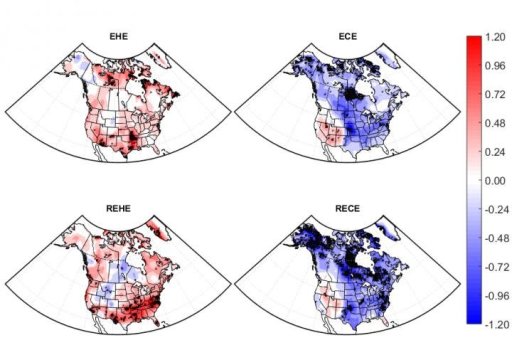[ad_1]
A new study shows extreme heat events both in the summer and in the winter are increasing across the U.S. and Canada, while extreme cold events in summer and winter are declining.
A new study in the in Journal of Geophysical Research: Atmospheres, a publication of the American Geophysical Union, examined absolute extreme temperatures — high temperatures in summer and low temperatures in winter — but also looked at relative extreme temperature events — unusually cold temperatures and unusually warm temperatures throughout the year.
The new study found both relative and absolute extreme heat events have increased across the US and Canada since 1980. This upward trend is greatest across the southern US, especially in the Ozarks and southern Arizona, as well as northern Quebec. That means there are more extremely hot days during the summer as well as more days that are considered extremely hot for the time of year, like abnormally warm days in the winter.
The new research also found both relative and absolute extreme cold events are decreasing, most notably in Alaska and Northern Canada, along with patches along the US Atlantic coast. In these areas, there are fewer instances of temperatures that are extremely cold either compared to the normal range, like in winter, or for the time of year, like unusually cold days in the summer.
Global mean surface temperature, the most frequently cited indicator of climate change, has been steadily increasing since the 1970s. However, temperature extremes pose a greater ecological risk to many species than average warming, according to the study’s authors.
The new study is one of the first to explore relative extreme temperature events, which are changing more rapidly than absolute temperature extremes, and can have important implications for the environment, agriculture and human health, according to Scott Sheridan, professor in the department of geography at Kent State University and lead author of the new study.
“Typically for this kind of research we look at the highest temperatures in the summer and lowest temperatures in the winter. But we’ve also seen that extreme temperatures that are really anomalous for the time of year can have a high impact — these relative extremes are important and underappreciated,” he said.
Investigating temperature extremes
To investigate how extreme temperature events have been changing over time, Sheridan and his co-author conducted a climatology of cold and heat events, both absolute and relative, for North America, followed by an analysis of how they have changed from 1980-2016.
Relative extreme temperature events are changing faster than absolute extreme events, and often occur outside of seasonal norms, according to the new study. In the eastern half of the US, relative extreme heat events occur as early as mid-winter into early spring. Out-of-season extreme temperatures can cause early thaws in mild winters or catch vulnerable populations unprepared and unacclimated.
Across parts of the Arctic, extreme cold events have become almost entirely nonexistent and increasingly difficult to identify, according to the researchers.
“Relative temperature anomalies can trigger what are called phenological mismatches, where a mismatch in the temperature and the season can cause trees to bloom too early and birds and insects to migrate before there is appropriate food,” Sheridan said.
Most notable is the highly anomalous warm event in March 2012, which included persistent mid-summer warmth in multiple locations. The event produced a ‘false spring’ in which vegetation prematurely left dormancy, so that it was not prepared for subsequent frosts, leading to large agricultural losses in certain areas, according to the researchers.
There is some evidence that early-season heat events are more hazardous to humans than heat events later in the season. When people are not acclimatized to hotter temperatures, they are more vulnerable to negative health impacts, especially the elderly, infants, young children, and people with chronic health problems or disabilities, according to the researchers.
The study clearly underlines the importance of not just looking at high temperatures in the summer but also looking at relative temperatures, said Kristie Ebi, professor of Environmental and Occupational Health Sciences at the University of Washington, who was not involved in the study.
“Using information generated in the study on regional patterns in extreme weather events, particularly relative extremes in temperature, early warnings could be issued that include information on what people can do to protect themselves and to protect crops and ecosystems,” Ebi said.
[ad_2]















